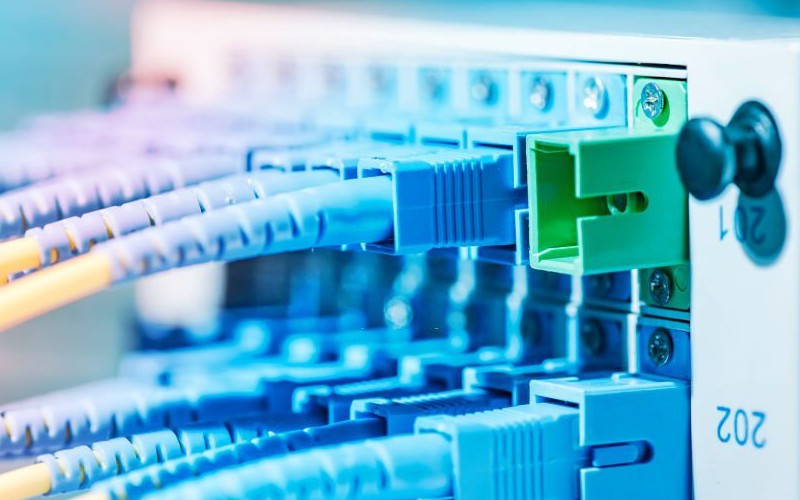Let’s explore the differences between a patch panel and a network switch. What is the difference between a patch panel and a switch? Many people who are new to computer building might be perplexed by this distinction.
However, each item serves an essential role. In this article, we will compare and contrast patch panels with switches.
What is a Patch Panel?
A patch panel, also known as a fiber optic patch panel or fiber optic enclosure, is a unit that houses terminations for network ports. It is often used in cable management solutions to organize and protect fiber optic cables.
In data centers, patch panels can help prevent damage to terminations from accidental knocks or other mishaps. Patch panels are available in various sizes and configurations to meet the specific needs of any application.
What is a Patch Panel Used For?
Running fiber optic cables directly from a fiber optic switch to a client endpoint would be difficult to manage in a network of any complexity. This is because the cables would be difficult to keep track of and more difficult to move.
Fiber patch panels provide an efficient solution to this problem by acting as fiber connection points to interconnect with the network fiber. This allows for easier network management while still providing the same level of performance.
In addition, fiber patch panels are typically much less expensive than fiber optic switches, making them a more cost-effective solution for many applications.
What is a Switch?
A network switch is a device in a data center that connects all devices in a LAN or WAN so they can communicate. It routes incoming data from multiple input ports to the specific output port that leads to the destination.
Modern network switches usually determine which output port to use by consulting the network address in Ethernet LANs or WANs. Network switches are essential to any computer network because they allow different devices to share data and resources without interference.
Without a network switch, each device would have to be connected directly to every other device in the network, quickly becoming unmanageable.
Network switches come in various sizes and speeds, depending on the needs of the network. For example, a gigabit Ethernet switch can provide up to 1,000 megabits per second (Mbps) bandwidth.
Some switches also have additional features, such as quality of service (QoS), which helps prioritize traffic on the network. Network switches are an important part of keeping a computer network running smoothly.
What is a Switch Used For?
When data is transmitted over a network, it must be properly routed to reach its destination. This is where network switches come in. Network switches actively filter and route data, ensuring it reaches the intended recipient.
In most cases, this is done using microelectromechanical systems (MEMS) to establish connections between different points. By manipulating micro mirrors, optical beams can be steered from inputs to outputs.
This allows for data to be quickly and efficiently routed across a network. While OSC and RCF technologies are also used for this purpose, they are generally less common than MEMS. As a result, most fiber optic switches use MEMS to filter and route data properly.
Do Patch Panels Affect Network Speed?
Patch panels are an important part of any network design, but there is a common misconception that they can slow down data transmission. When patch panels are used correctly, they have virtually no effect on data speed.
Multiple patch panels can be used after a network switch, and the loss on individual connectors will still be negligible. Patch panels are meant to complement switches, not replace them.
They provide a convenient way to connect and disconnect devices, and their flexibility makes them an essential part of any well-designed network. So don’t overlook their importance in your next network design project.
Why Do You Need A Patch Panel If You Have A Switch?
Regarding business communications, patch panels provide a high degree of flexibility and reliability. Patch panels allow you to connect different types of equipment easily and can be used to connect equipment in different locations.
If you need to change something or something breaks, you can swap out the patch panel without re-running cables or moving equipment around.
Patch panels also allow you to punch down the cable, which provides mechanical relief to the switch ports. As a result, patch panels can save time and money by allowing you to quickly and easily change your business communications setup.
Do I Need A Patch Panel For Home Network?
A patch panel for the home network is not necessary but is preferred. There are several reasons why terminating cables into a patch panel is preferable to leaving them loose.
First, it creates a much neater installation. Second, it is much easier to label the cables when they are terminated into a patch panel. Third, patch cables are much easier to work with than solid core cables.
Patch cables are made of stranded core material, which is more flexible and easier to route than solid core cables. As a result, terminating cables into a patch panel is the best way to ensure a professional-looking installation that is easy to maintain and troubleshoot.
Conclusion
Network switches are an important part of any computer network. They filter and route data, ensuring that it reaches the intended recipient. Patch panels are another important piece of equipment, providing high flexibility and reliability.
When designing a network, it is important to consider the needs of the business and the best way to meet those needs. In most cases, a combination of network switches and patch panels will provide the best results.






